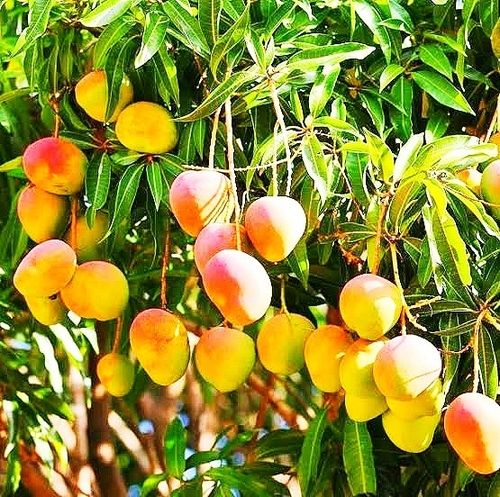Mango, (Mangifera indica), member of the cashew family (Anacardiaceous) and one of the most important and widely cultivated fruits of the tropical world. The mango tree is considered indigenous to southern Asia, especially Myanmar and Assam state of India, and numerous cultivars have been developed. Mangoes are a rich source of vitamins A, C, and D.
For more information, read full article with Pritish Kumar Halder.

Physical description
The tree is evergreen, often reaching 15–18 meters (50–60 feet) in height and attaining great age. The simple leaves are lanceolate, up to 30 cm (12 inches) long. The flowers—small, pinkish, and fragrant—are borne in large terminal panicles (loose clusters). Some have both stamens and pistils, while others have stamens only. The fruit varies greatly in size and character. Its form is oval, round, heart-shaped, kidney-shaped, or long and slender. The smallest mangoes are no larger than plums, while others may weigh 1.8 to 2.3 kg (4 to 5 pounds). Some varieties are vividly colored with shades of red and yellow, while others are dull green. The single large seed is flattened, and the flesh that surrounds it is yellow to orange in color, juicy, and of distinctive sweet-spicy flavor.

History
The mango is inextricably connected with the folklore and religious ceremonies of India. Buddha himself was presented with a mango grove that he might find repose in its grateful shade. The name mango, by which the fruit is known in English- and Spanish-speaking countries, is most likely derived from the Malayan manna, which the Portuguese adopted as manga when they came to Kerala in 1498 for the spice trade. Probably because of the difficulty in transporting seeds (they retain their viability a short time only), the tree was not introduced into the Western Hemisphere until about 1700, when it was planted in Brazil; it reached the West Indies about 1740.
:max_bytes(150000):strip_icc()/grow-mango-seeds-1902625-04-ad10ef4af2b34ca68c3bf240a04a3cff.jpg) Popularity
Popularity
After enjoying the fruit, don’t throw out the mango pit! Instead, grow a mango from seed as a new houseplant.
In the last 10-15 years, the popularity of mangos has exploded in the United States. These delicious tropical fruits are now found for sale in all parts of the U.S. even as far north as Alaska. In addition to indulging in the sweet treat, you might be surprised that you can grow mango seeds from the fruit into a new plant right at home. And if you happen to live in the warmer regions of the US (USDA Zones 9+), you can even plant mangos outdoors. In cooler climates, you can find success growing mangos from seed and keeping them as houseplants.
Planting a Mango Seed
The process of growing mangos from seed is actually pretty simple. While care should be taken during the extraction of the seed, both adults and children might find the process fun and worthwhile. Before you begin, make sure you have all your materials in place and ready to go.
- Mango
- Knife
- Scissors
- Paper towels
- Zip-top plastic bag
- Potting soil
- Container

Step 1
The first step in the process is also the best: eat the mango! Before the large seed can be removed, the fruit’s flesh should first be removed. Depending on the ripeness of the mango in hand, the rind can often be peeled off relatively easily; the bright orange flesh can either be sliced off with a knife or eaten somewhat like an apple. In either case, having some floss handy afterward is recommended.

Step 2
After the husk has been thoroughly cleaned, let it dry for about 24 hours. Then, remove the seed from within the white outer husk. With the seed husk in hand, use scissors to cut a portion of the “thin side” of the husk. After an initial hole has been opened up, use the scissors to cut along the side of the husk to reveal the seed within. Be very careful during this stage, as the husk and seed can be slippery. The seed inside the husk should be white in color. Any brown or black coloration or patches usually means that the seed is no longer viable.
/person-watering-planted-mango-seed-0e478e1df4d04565bd630a1ff08bfcd3.jpg)
Step 3
Remove the seed from the husk. You may potentially get more than one seed. Whether you see one or two depends on the variety. If you do see multiple seedlings, they can gently be separated and planted individually.

Step 4
Wrap the seedling(s) in wet paper towels. One standard size wetted towel will be sufficient to wrap fully around an individual seedling to keep it from drying out. Once wrapped, put the seedling(s) in a zip-top plastic bag and keep in a warm, bright location until green growth begins to appear. Depending on the warmth of the location and maturity of the mango when it was picked, this waiting period can be anywhere from a few days to a couple of weeks. Be patient and avoid moving the bag around.

Step 5
Once green growth has appeared, take the seedling out of the plastic bag and gently unwrap the paper towel. In your container filled with fresh potting mix, place seedling(s) at just enough depth to cover the majority of the seed without covering the new green growth. Keep your new plant’s soil moist at all times and put it in a warm, sunny location. If you want to move your new mango plant outdoors, first give it a one-week period in dappled shade before placing it in full sun.
How to Care for a Mango Plant
Mangos are full-sun (8+ hours of sun per day) in the tropics; these plants do best with lots of light, warmth, and humidity. If you live in parts of the southern United States like Florida or coastal Southern California where frosts are rare, you can plant your mango seedling directly outside. For the rest of the country, mangos can be grown indoors along a south-facing window. The addition of artificial lighting will be necessary in northern climates and areas that do not receive strong, full sun.

Otherwise, caring for your mango tree as a houseplant is as simple as growing other well-known indoor trees such as the common weeping fig. Give your mango plant a well-balanced fertilizer for the first few years of growth and then switch to a mix that’s higher in phosphorus and potassium. A little goes a long way, so don’t be tempted to add more than the package directions indicate. And only apply fertilizers during active growth in the spring and summer. Be sure to keep the soil moist for the first couple of years. Once the seedling has outgrown its first pot, transplant into a pot one size larger.
Reference
https://www.bhg.com/gardening/vegetable/fruit/how-to-plant-a-mango-seed/











